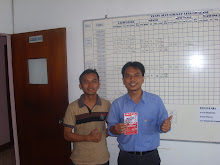Translation II
In translation procedures, they may involve essentially adding structural or lexical elements to those present in the SL or substracting from them; eliminating elements that are obligatory in the SL but unnecessary in the TL or with no counterpart there, and where disparity between the two media goes beyond language patterns, adapting the content of the message so that the TL text will come as close as possible to the intent of the SL text and create a similar impact. …
a.Saya ….. …. guru
I am a teacher (adding)
b.Saya kembali ke rumah
I returned …. Home (substracting)
c.Paul is a bookworm
Paul … … kutubuku (substracting +adapting)
d.….. perlu diketahui bahwa ….
It is necessary to know that …… (adding+adaptimg)
Translation in a very broad sense of the term can be listed in terms of different levels of complexity (Pinchuck, 1977:88). The procedures can be in the form of:
1.Transcription
This means rendering the sounds of an SL into a TL form, e.g.
Indonesian English
Achmad - Ahmed
Betawi - Batavia
Orang hutan - Orangutan
2.Transliteration
This is the process of rendering the letters of one alphabet into the letters of another with a different alphabetical sistem. For example, from the Russian Cyrillic alphabets into the latin ones or from Arabic into Chinese. No transliteration takes place between Indonesian and English since both use the Latin alphabets.
3.Borrowing
Many types of borrowing are made from one language to another. A procedure often used when the TL has no equivalent for the SL units is to adopt them without change but sometimes with spelling or pronunciation adjustments. Look at the examples below:
Indonesian English
Sampan - sampan
Kampung - kampung
Durian - durian
Sandal - sandal
Kapuk - kapok
English Indonesian
Memo - memo
Atom - atom
NATO - NATO
Astronaut - astronot
Taxi - taxi
4.Literal
This is one-to-one structural and conceptual correspondence. It can include borrowings and word-to-word translation. This presupposes a kind of interlingual synonymy. Look at the examples below:
Indonesian English
a). 5 buku - 5 books
Mary telah datang - Mary has come
John sedang menyanyi - John is singing
b). opelet - jitney
kepinding - bedbug
limas - pyramid
garuk - scratch
keok - defeated
pari - nymph
5. Transposition
This is one of the most common procedure used in translation. It involves replacing a grammatical structure in the SL with one of a different type in the TL in order to achieve the same effect .
a.Perlu diketahui bahwa menulis modul itu memakan waktu (passive/Indo.)
You should know that module writing takes time. (active/English)
b.I would have come if Ihad known. (Eng.)
Saya tentu datang bila saya tahu. (Sayang sekali saya tidak tahu maka saya tidak datang)
6.Modulation
Modulation and transposition are the two main processes in translation. Modulation entails a change in lexical elements, a shift in the point of view. Transposition and modulation may take place at the same time.
Examples:
a.Time is money (SL)
Waktu itu sangat berharga (TL)
b.When I told him I won a prize at a lottery he called me a lucky dog (SL)
Sewaktu kukatakan kepadanya bahwa aku menang lotere dia menyebutku orang yang beruntung. (TL)
c.I have told him many times not to interfere other people’s business – but being pig-headed he still does. (SL)
Telah kukatakan kepadanya berulang kali untuk tidak mencampuri urusan orang lain – namun karena keras kepala dia masih saja mencampuri urusan oranglain. (TL)
7.Adaptation
This procedure is used when the others do not suffice. It includes modifying the concept, or using a situation analogous to the SL situation though not identicalto it. An adaptation may at the same time entail modulation and adaptation. It goes beyond languages. You can read Dicken’s The Graet Expectation in its adapted form more easily and understandingly.
In translating from one language into another language transposition and modulation are obviously the most important that should be taken into account by the translator. Normally he should always study the text as a whole before he begins to translate it. After obtaining a picture of the whole he can break it up into its parts. The analysis will move in the opposite direction from the fragments to the whole, from the simpler to the more complex. The smallest unit of equivalence should be determined first. The levels of equivalence is ascending order as follows:
1.Substitution of printed letter for printed letter. For examples from Arabic into Roman, from Japanese into Roman, or from Chinese into Roman.
2.Substitution of morpheme for morpheme. Examples:
Kerja - work
Pekerja - worker
Bekerja - work/works/worked
3.Substitution of word for word. Examples:
Careful - hati-hati
Open - terbuka
University - universitas
4.Substitution of phrase for phrase. Examples:
A careful worker - seorang pekerja yang hati-hati
Open university - universitas terbuka
5.Substitution of sentence for senbtence. Examples:
a.Lala is a careful worker in LG Company
lala seorang pekerja yang hati-hati di perusahaan LG
b.She always works carefully
Dia selalu bekerja dengan hati-hati
6.Substitution of Paragraph for paragraph
7.Substitution of discourse for discourse.
(Cikarang, august 1, 2009)
Jumat, 31 Juli 2009
Langganan:
Posting Komentar (Atom)








.jpg)




hi,,
BalasHapussaya aisyah asal jambi,,.,
saya sedang mencari data2 tntang translation prosedure,.,kebetulan ketemu dgn artikel anda,,
dan isiny sangat sesuai dgn yg saya cari,,
apa anda punya buku tentang artikel ini??coz, saya ada jg copianny, n sama banget dgn artikel ini,cuma sampai adaptation.